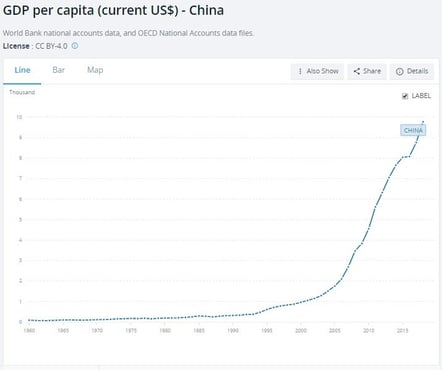With all the talk of trade and tariffs it’s worth it to take a step back and think ‘how much does this trade relationship really matter’? Sure China’s big with a big population and big markets to sell to but China is still a ‘developing country’ with real economic challenges ahead of itself, why should we care?
Scale. Massive scale. Just imagine if China became as productive as the US.
Think about this; if every Chinese citizen were currently able to produce the same amount per person as we do in the US, China would now produce as much as the rest of the planet…combined. Bigger than big.
What?
GDP (Gross Domestic Product) is a measure of all goods and services produced by a single country (total stuff produced by one country). Now, GDP per capita is a measure of economic production measured by population (total stuff produced per person in that country)..
If China’s 1.4 Billion people were able to produce goods and services at the level (per person) of the United States, their Gross Domestic Product would be 89.4 Trillion dollars, more than the entire planet combined. See below for all the numbers and calculations *
FYI, current World GDP (all the stuff currently produced everywhere) is 85.8 Trillion dollars. (Source: World Development Indicators, The World Bank 2018.).
China is an inconceivably large potential market and could dominate all aspects of international trade…and the winners for the next century may be the vendors supplying that market.
Is it possible for the Chinese to reach that level of production? Probably not. The challenges for available resources, stresses on productivity, pollution, refuse, physical space, demographics, an undeveloped personal credit market, and a host of other forces can create serious headwinds and limitations going forward.
But the Chinese are taking aggressive steps to develop its own economic sphere of influence, witness the ‘Made in China 2025’ plan and the ‘Belt and Road’ initiative (see below for excellent articles on these potentially game-changing programs). These programs can broadly expand Chinese influence in other parts of the world without the need of engaging with more developed nations and without challenging more established trading blocs. If it works, China can ‘go it alone’ within its own sphere of influence.
Since 2008 Chinese per capita GDP has tripled. Take a look at the graph below (source: World Bank national accounts data, and OECD National Accounts data files.)

China has benefited over the last 30 years from an open trade structure where they were able to leverage off their massive labor advantages. This is changing as global trade partners (both nations and corporations) take stock of the implications of current Chinese trade practices.
Questions being asked surrounding current risks of operating in China:
-
Intellectual Property Rights: Can patent rights be upheld against “bad actors” in the Chinese economy? While there have been changes to laws regarding this issue in the past few years, history says ‘not really’.
-
“One in five US companies say China has stolen their Intellectual Property”: https://fortune.com/2019/03/01/china-ip-theft/
-
Forced Technology Transfer: Is it worth giving up a competitive advantage (ie proprietary technology) to participate in this market?.
This could prove the single largest global economic question for the next 20 years: Is it worth operating in China if a foreign firm’s competitive advantage is taken from them?
One can argue whether tariffs are the best way to confront this issue but the issue must be addressed, preferably in a coordinated way between global trading partners.
There are two basic options for China, cooperation with larger trading partners or cooptation of lesser partners. One way presents a great probability of continued economic expansion, the other creates an economic headwind.
How does this affect your portfolio? In the long-run emerging markets could benefit either way as production shifts to a lower cost, lower risk provider. Unfortunately natural resource/ commodity firms will boom and bust according to Chinese cycles of production. The US market will be affected but remember, pre-tariffs China only bought $505 Billion of US goods*** (only 2.4% of US GDP) so, given low interest rates and moderately benign business conditions US-centric businesses should be shielded from this conflict.
As this narrative unfolds be prepared for some periods of higher volatility. If you’re an optimist, it’s a buying opportunity. If not, keep in mind that China’s per capita GDP is still just 15% of the US level; going forward China may have no choice but to cooperate with trading partners around the world in order to continue their unprecedented economic expansion.
Brian Kearns
Haddam Road Advisors
* The $89 Trillion calculation:
-
According to the World Bank, in 2018 the US generated 20.49 Trillion dollars in goods and services. China produced 13.6 Trillion dollars. That’s number one and two for top GDP (Japan is number three with 5T).
-
The World Bank also reports that US per capita GDP was $62,641, China’s was $9,770.
-
The United Nations reports China’s population stood at 1,427,647,786 in 2018, the United States came in at 327,167,424.
-
So if 1,427,647,786 people could produce $62,641 each, they would produce 89 Trillion Dollars of stuff.
** Made in China 2025 and China Belt and Road articles:
https://www.cfr.org/backgrounder/made-china-2025-threat-global-trade
https://www.cfr.org/backgrounder/chinas-massive-belt-and-road-initiative
*** 2017 US census
This is being provided for informational purposes only and is not intended as a recommendation to buy or sell any specific security. Past performance is no guarantee of future results and all investing involves risk.
- April 2025 (4)
- March 2025 (2)
- February 2025 (1)
- January 2025 (8)
- December 2024 (1)
- November 2024 (8)
- October 2024 (6)
- September 2024 (1)
- December 2023 (1)
- November 2023 (1)
- October 2023 (1)
- August 2023 (1)
- May 2022 (1)
- February 2022 (1)
- September 2020 (1)
- August 2020 (2)
- June 2020 (1)
- February 2020 (1)
- January 2020 (1)
- December 2019 (4)
- November 2019 (2)
- October 2019 (1)
Subscribe by email
You May Also Like
These Related Insights

The 4 "Solutions" to Negative Cash Flow

The 4 "Solutions" to Negative Cash Flow


